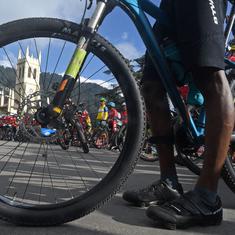The first time I saw him was late in October of 1983 as he leisurely strolled the shores of Rajbagh Lake. I knew a new male had arrived. He was a big guy with great ruffs of hair on his cheeks and a huge belly. He walked with a swagger as if he had not a care in the world – he seemed to know that this area of the lakes was his kingdom. It is after the monsoon that new territories are taken over and the areas re-marked as the monsoon washes off the scent of tigers. The lake area of Ranthambhore is a network of three lakes – Padam Talao, the lotus lake, and Rajbagh, the garden of kings, are separated by 20 metres and Rajbagh and Malik Talao by about 200 metres. Malik is small compared to the other two and all three are surrounded by a 10-foot-high khas grass wall that provides camouflage for both predator and prey. As the winter sets in and water starts to dry up in the hills the sambar move downwards in search of greener pastures. Their very special addiction in Ranthambhore is the succulent water plant that overruns the edges of the shallow waters and the lotus flowers that carpet both Padam Talao and Rajbagh. The sambar enter the water to feed and you can see their ears or antlers on the surface as they swim or wade through, gorging themselves on the surface as they swim or wade through, gorging themselves on these water plants. They rarely bother about the crocodiles so acute is their addiction. This activity reaches a feverish pitch by March at the onset of summer and this is also when the crocodiles warm up to action and attack. (These cold-blooded reptiles do little in the chill of winter except take in the sun.)
Large male tigers are difficult to see in this setting. Our only glimpses in 1983 were of the Bakaula male a large, handsome male with a much darker coat than most, who in the hot summer was to be found in the cool jamun pools of Bakaula, or of Broken Tooth, a very muscular male, who would in a couple of years lose half an upper canine probably while attacking a sambar, as he paced up and down the Kachida Valley. The Bakaula male was sometimes invisible in the jamun groves and I remember one evening waiting for him to emerge for two hours. Finally, in sheer desperation, I started mimicking the tiger’s call. In minutes, an enormous tiger head emerged from the bushes and the animal paced towards me looking at me disdainfully before walking away.
We seldom saw a big male by the lakes so our sightings of the Bakaula male took one and all by surprise. He was my favourite big male of the mid-1980s. His coat was deep and rich and his face big. The ruff around the cheeks was full. He was easily the most handsome male tiger I have seen. He was very even-tempered. He loved the cool waters of the Bakaula area where he could frequently be found immersed in the water, cooling off on a hot summer’s day.
In November 1983, after an early morning drive I was lazing around on the balcony of Jogi Mahal when suddenly from across the lake came a cacophony of alarm calls of sambar. I was stunned to see Genghis racing after a young sambar who splashed across the edge of the water. Tigers wade through water and this was an activity that the tigress we called Nick Ear enjoyed in her early years. But I had never seen a tiger chasing a deer in the water. Genghis didn’t falter and charged in as sheets of water splashed skywards from the flight of the sambar and the tiger’s pursuit of the deer. He missed, but what a spectacle he had created. An orchestra of alarms resounded over the lake as sambar competed with monkey and peacock and greylag geese took flight. Genghis paused, looked left and right, surveying the chaos he had created, and then retreated into the grass. What I had seen was so intense that it was like being witness to a theatrical extravaganza.
Little did I realise then that this would be a major feature of Genghis’s strategy from 1983–84. During that time he seldom strayed far from the lakes. He had adapted his predatory activity after assessing all the factors that had created this haven for sambar in the water and chital grazing on the green shoots at the edges of the lakes. In all these decades this behaviour of a big male only engaging with the lakes has never been repeated. For nearly eight months he remained rooted to the lakes, an area of 5 square kilometres.
My first encounters with Genghis were in the chill of winter. I remember 15 January 1984 vividly. It was a very cold night and I had just left the warmth of the fire at Jogi Mahal to head for my sleeping bag. As I was about to enter my room the resounding roar of a tiger shattered the silence. It was so close that I was stunned. Barely 15 metres away a black shadow walked across Jogi Mahal roaring continuously. The sound continued for nearly half an hour as the tiger walked around Padam Talao. As the tiger’s roar reverberated in my head, I realised that Genghis was asserting his presence across the lakes. His sounds could attract or repel conflict and were like territorial signals.
The next morning was very cold. My hands froze on the wheel of the jeep and I could barely feel them. The forest floor was covered with frost. I circled Padam Talao and saw the scarlet sun peeping out over the hills of Ranthambhore. Slowly the day grew warmer as the sun rose. I searched the edges of the second lake and stopped to listen for calls. The sun flooded the lakes and was a delight as it warmed the body. This is always a very special moment in a forest – from freezing temperatures, the warmth of the day warms every pore in the body. Suddenly, on the path in front was Genghis walking towards me. The unmistakable glow of the striped coat, the powerful, unhurried, silent walk. The power and beauty of the moment was spellbinding. He suddenly flushed out a wild boar with three piglets from the high grass. They went scampering off in different directions. Within seconds, Genghis had pounced on a piglet and squeezed the life out of it. The sow stopped in mid-flight but there was nothing she could do to help her baby. Genghis carried off the piglet into high grass. A covey of quail came rushing out and in the distance peafowl called in alarm.
While Genghis was feeding in the high grass on the remnants of the tiny piglet, I parked 100 yards away at the edge of the lake, hoping he would come to the water’s edge. I suddenly spotted the sow approaching the grass to check on her baby but Genghis darted out and she fled. It is astonishing to observe the plight of a mother at the loss of her young. I have witnessed this even with deer as they approach tigers who have killed their offspring. At about 2.30 pm, a group of sambar appeared on the shore and started to move towards Genghis. He suddenly erupted from the grass in a headlong charge, scattering the panic-stricken deer. The sambar flashed past our parked jeep and only at the last second did the charging tiger brake to a halt in front of the jeep. Slamming his forepaws into the ground he veered away, snarling viciously at his unsuccessful attempt. Thirty-two years later every detail of that encounter is still etched on my brain. The pure power of the tiger inspires awe. Genghis was a massive male tiger weighing approximately 230 kilograms with a thick ruff of hair on his cheeks and eyes that bored through you like a drill. Totally fearless he was always on the move and very active even in the middle of the day. Aggression was a part of his very nature – if he did not like human behaviour in the jeep he would be quick to snarl and even race up to you roaring loudly. He was a great tail twitcher and much more aggressive than either Padmini or Noon.
In late February 1984, as the seasons changed, I woke up at dawn to the death cry of a sambar in Padam Talao. I could see that a crocodile had made a kill. I quickly drove down to the water for a better look. But someone else had beaten me to it. Genghis sat on his haunches staring fixedly at the crocodiles trying to yank on the carcass. After forty-five minutes, as the sun’s rays lit up the lake, he entered the waters of Padam Talao wading through lotus flowers towards the carcass. As he approached he was snarling viciously and beating his paws in the water to fight off the crocodiles. He snatched the carcass away, and with a firm grip on its neck, swam back to shore with his prize.
I was astonished to say the least. I would never have dreamt that I would see such tiger-crocodile interactions in the waters of the lake. Through March, April and May of that year it was non-stop – Genghis either usurping kills from the crocodiles or attacking sambar in the water. I must have witnessed at least fourteen kills being made. Noon, who was the area’s resident tigress, and Genghis’s mate, must have been watching carefully for she would learn this art of water predation from the master. I began to watch Genghis’s every move. Fateh teased me that I had become Genghis obsessed. “He wasn’t wrong. I felt I was in tune with Genghis as I had observed him so intensely. It got to be so that I was usually able to find him whenever I went looking for him. Genghis was a tough tiger and highly individualistic. He was happy to be observed at close quarters but never permitted anyone nearby whilst eating. This was his private moment and if you ventured close he would snarl viciously and mock-charge the jeep. I experienced this once and it was enough. Visualise an enormous male tiger snarling at you from 2 feet away. After that I never went near him while he was eating.

Excerpted with permission from Living with Tigers, Valmik Thapar, Aleph Book Company.










